A gigantic jigsaw puzzle
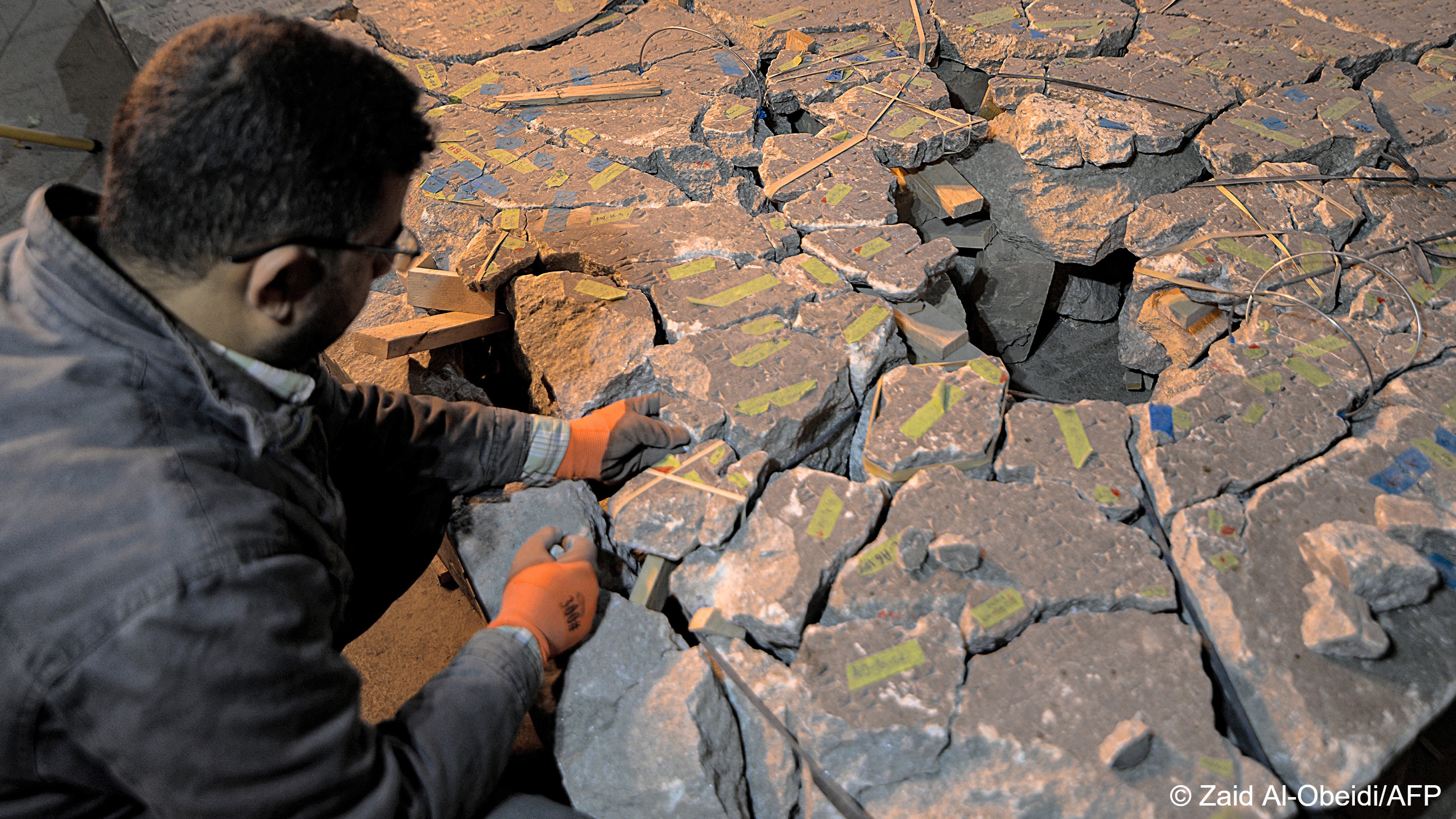
Can it be done or not? That was the question Daniel Ibled asked himself when he came to Mosul for the first time, four years after Islamic State (IS) fighters laid waste to the northern Iraqi city and its museum. He recalls how they walked over a layer of dust ten centimetres thick inside the museum.
Over the remains of what had once been its treasures: 25,000 books from the library, which had most likely gone up in flames as a result of the huge explosion that the IS fighters caused to blow up the millennia-old base of an Assyrian throne. Also reduced to dust and rubble were an Assyrian lion and two Lamassu, mythical creatures with human heads, the wings of an eagle and body of a bull.
The destruction of these Hatrene statues, which were first toppled from their plinths and then broken up with jackhammers, was documented by members of IS. The notorious video was seen around the world in February 2015.
Ibled came into the museum as a man who, at the age of six, had taken pleasure in piecing back together the shells of cracked nuts, and who had already helped restore artefacts destroyed by the Taliban in Afghanistan. He is now working on a project that his boss Ariane Thomas, the head of the near-eastern antiquities department at the Louvre, describes as a "nightmare jigsaw puzzle".
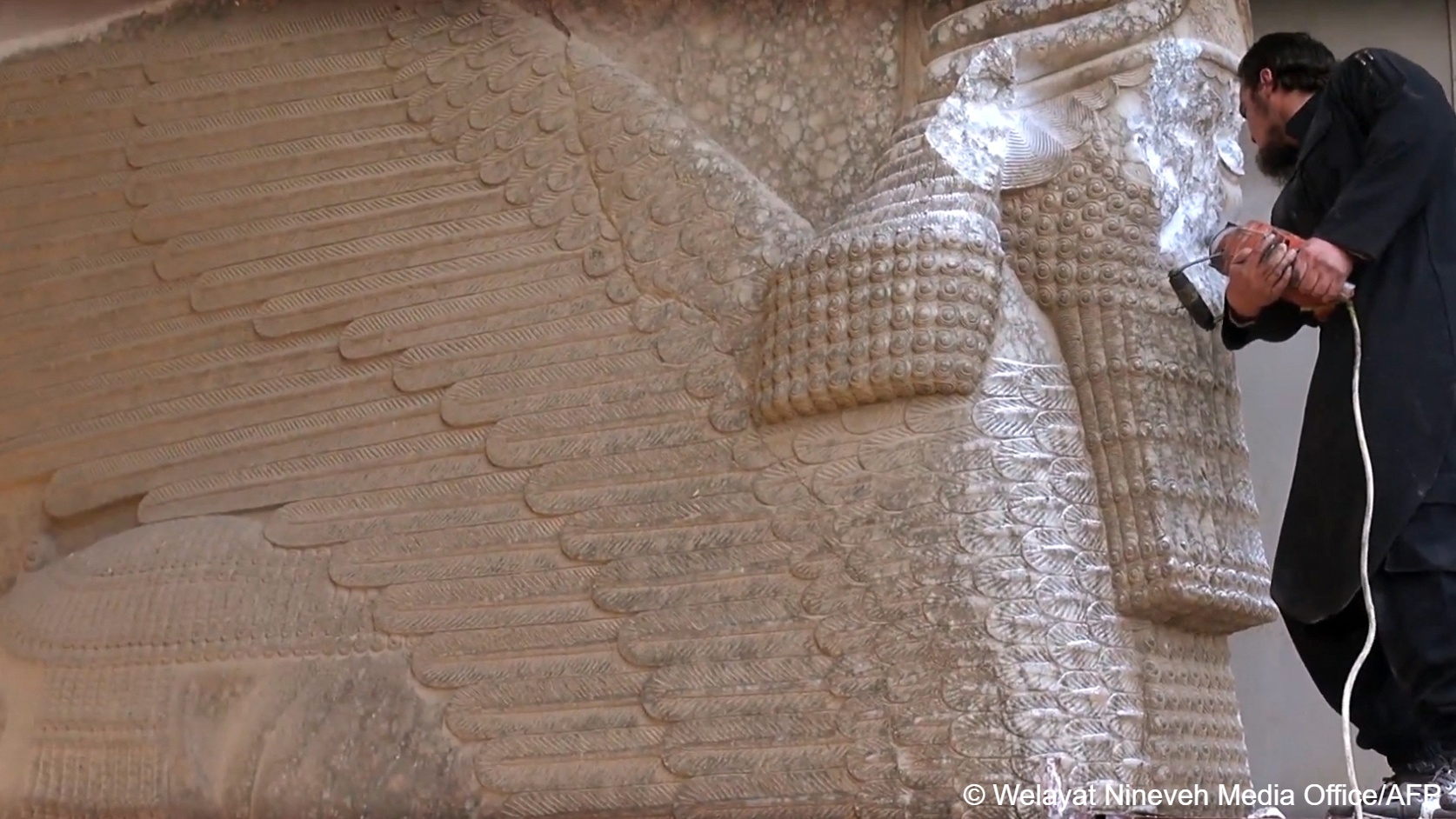
Daniel Ibled and his team are piecing back together the remains of the Mosul Museum's treasures that were destroyed by IS. For almost two years, they have been hunting through many thousands of fragments to find the ones that go together.
Some are large and weigh twenty kilos, despite the IS fighters' best efforts to break them up as much as possible. Others are the size of half a fingernail. They are lying all across the rear galleries of the museum, which took a whole year just to clean. First, the restorers from France laid out a grid on the floor, then they packed each square of the grid into its own crate.
The internal logic of explosions
Many individual parts have now been sorted, numbered and categorised, and are lying on wooden pallets in rooms that once again exude a sense of order. Large parts of the throne base, with cuneiform writing on its top and bottom, on which the throne of Assyrian ruler Assurnasirpal II is said to have stood in the 9th century BC, are held together with rubber bands. They bear scars of glue.
“Every explosion has an internal logic,” says Ibled. Once you manage to grasp that, you can think through the explosion in reverse, so to speak, and find the pieces of the puzzle more easily. What happens next, according to Ibled, requires perfectionism. If you are out by just a millimetre at the start, the errors multiply with every subsequent step, until you end up with something so crooked that it is impossible to add more pieces of stone to it. “In the beginning, we sometimes had to rein our Iraqi colleagues in for that reason.”
For two years now, eight employees of the Louvre have been coming from Paris to Mosul for a few weeks in rotation, gradually teaching the Iraqi restorers what they need to know. This training programme is part of the agreement on the reconstruction of the museum made between the Louvre, the World Monuments Fund, the Smithsonian Institution and the Iraqi Office for Antiquities.
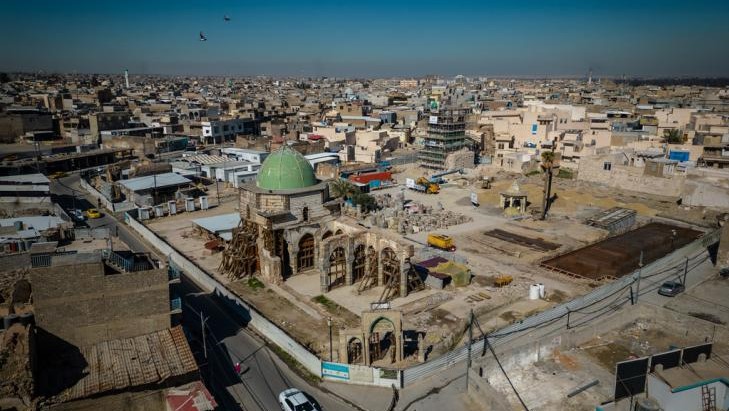
World heritage rapid reaction squad
The plans are made, and the money is in place – provided by Aliph, an organisation formed on France’s initiative in 2018 and making skilful use of its diplomatic contacts in the region. Aliph is largely funded by France, Saudi Arabia and the United Arab Emirates – it recently brought together 90 million Euros of investment over five years. It sees itself as a rapid reaction squad, committed to the unbureaucratic rescue of cultural heritage sites under threat in crisis zones. Right now, its primary focus is on Ukraine and Iraq.
In Iraq alone, Aliph is supporting around forty projects to the tune of 30 million dollars. The reconstruction of Mosul Museum is the largest of these, but not the only one in the city. Islamic State destroyed several dozen sites of historical significance and religious buildings in and around Mosul – monasteries, churches, temples and even mosques like the one on the Tell Nabi Yunus, built over the grave of the biblical prophet Jonah.
Archaeologists have long suspected (and Islamic State also knew) that beneath the mosque lies a large palace from the Assyrian empire. Hoping to unearth the treasures of this palace and sell them on the black market, members of IS dug long tunnels through the earth all over the site. The bitter irony: since IS was driven out, German archaeologists have used these same tunnels to finally explore the millennia-old palace. Its throne room, metres-tall guard statues and royal inscriptions have since been discovered.
A small exhibition in the museum provides information on the excavations, the destruction and the plans for rebuilding, and the museum has opened its doors to the public again in order to show it – for the first time in twenty years.
The museum was closed in 2003 when the American invasion began. At that point, all the art treasures that could be moved were transferred to Baghdad where they were supposed to be safe – the curators weren't to know that the Iraq Museum there would also be looted quickly and purposefully.
It was only ten years later that the decision was made to reopen the museum in Mosul, but before it actually happened, IS had gained control of the city and large parts of the surrounding area. Now this small exhibition contains a lot of before-and-after photos.
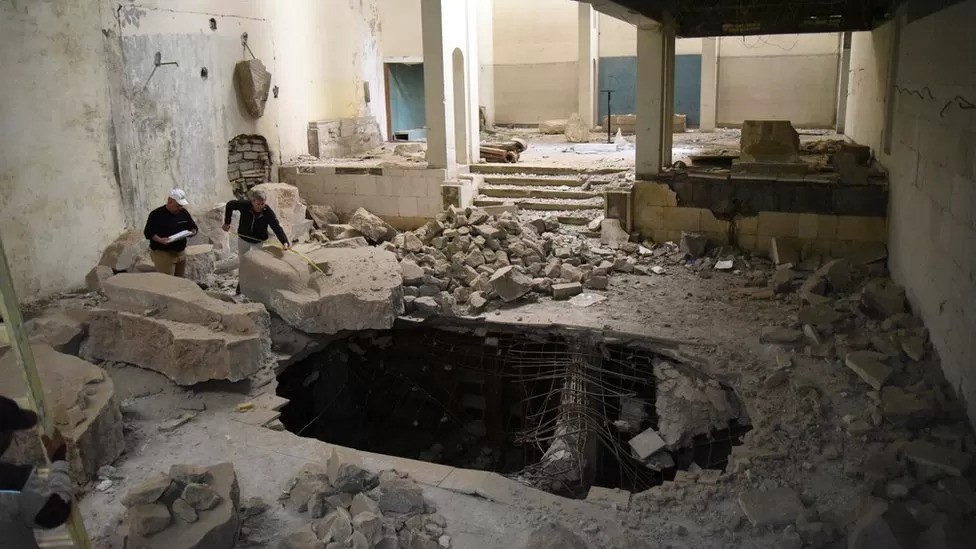
There are shocking images of the Nergal Gate in old Nineveh, Nimrod and Mosul’s old town, priceless cultural heritage sites that are in part irreparably lost. But the exhibition also documents the will to save what can be saved – something that leaps out at you as soon as you begin to approach the city.
Driving through the undulating, barren landscape, you pass kilometre after kilometre of petrol stations, workshops, heavy construction machinery, scrap merchants, spare parts and tyres for the large lorries that thunder back and forth between the Kurdish city of Erbil and Mosul without pause.
The museum is scheduled to re-open in just three years’ time. The building is heavily scarred by grenades, fire and explosives. Strips of twisted aluminium still hang from the scorched black ceilings, and a huge hole gapes in the floor where the base of the throne was blown up.
According to the wishes of the city’s residents, whose opinions were sought in a community outreach project, the hole is to remain as a reminder of those dark days. But it has also been decided to restore the brightness of the building’s original design by architect Mohamed Makiya, and to reglaze the facade which had been increasingly bricked up over the decades, probably for various security reasons.
This means modernism is also coming into its own here, which is remarkable insofar as the architectural legacy of this comparatively recent period has often faced difficulties in the Arab world.
Sold on the black market
And what will there be to see in this museum? The members of Islamic State didn’t leave a great deal behind. A wooden cenotaph with Koranic inscriptions and a pair of double doors from the 13th century AD were the only things to survive their iconoclastic destruction largely intact.
All the pre-Islamic art treasures fell victim to the fundamentalist IS ideology, which doesn't tolerate any cultures or history but its own – though only if they were too heavy to transport. The more portable works were most likely looted and sold on the black market to put money in the war chest.
No one here dares hope that any of the roughly seventy vanished works will turn up again. Although by his own account Laith Majeed Hussein, the head of the governmental Office for Antiquities in Iraq, has already ordered that all the finds from the excavations in Nineveh are to be brought to the museum in Mosul.
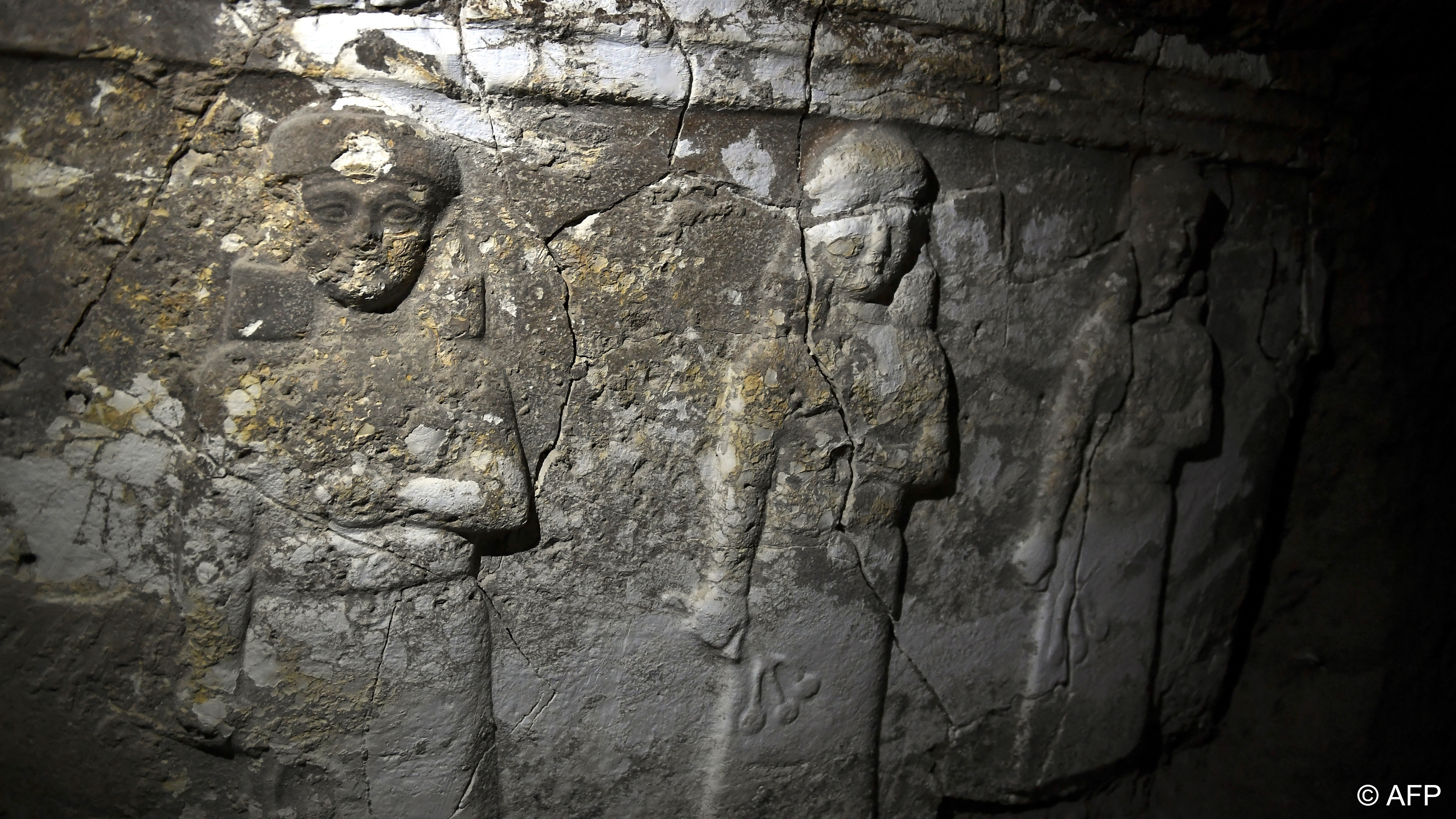
The building will also become home to artefacts from the depot in Baghdad. In addition, a good 17,000 cultural items largely stemming from the Sumerian period were returned to Iraq two years ago from the USA. And more than 6000 archaeological treasures recently came back to Iraq from London. The British Museum received them as loan exhibits – in 1923. "We're showing the world we're serious about repatriation," says Hussein.
Daniel Ibled is also confident that his restorers will have pieced the base of the throne back together by the time the museum reopens. The lower part of the lion is already recognisable, though it still has quite a large hole in the centre of its belly. "That's where the explosives were placed," says Ibled. But many of the fragments have been found and are shaped like slices of bread that will now be lined up one beside another.
Is there really no 3D imaging machine, no artificial intelligence that could help with this work? Maybe ten years from now, says Ibled, but not yet. You still need a human brain for this work. And a mind able to counter the doggedness of the destroyers with a lightness that helps to overcome moments of despondency.
You have to see it as a game, says Ibled. "As long as it's a game, it can be done."
© FAZ/Qantara.de 2023
Translated from the German by Ruth Martin
